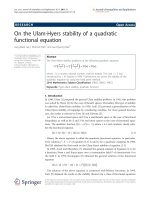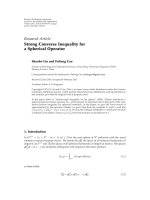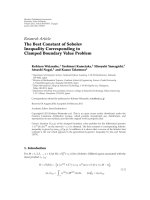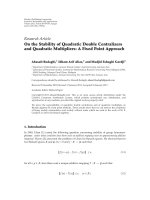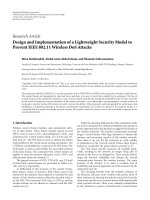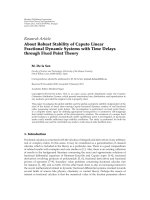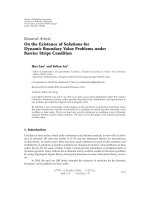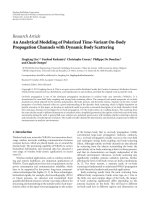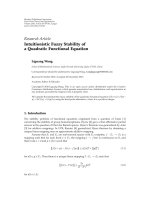Báo cáo hóa học: " Research Article Intuitionistic Fuzzy Stability of a Quadratic Functional Equation" pptx
Bạn đang xem bản rút gọn của tài liệu. Xem và tải ngay bản đầy đủ của tài liệu tại đây (471.4 KB, 7 trang )
Hindawi Publishing Corporation
Fixed Point Theory and Applications
Volume 2010, Article ID 107182, 7 pages
doi:10.1155/2010/107182
Research Article
Intuitionistic Fuzzy Stability of
a Quadratic Functional Equation
Liguang Wang
School of Mathematical Sciences, Qufu Normal University, Qufu 273165, China
Correspondence should be addressed to Liguang Wang,
Received 6 October 2010; Accepted 23 December 2010
Academic Editor: B. Rhoades
Copyright q 2010 Liguang Wang. This is an open access article distributed under the Creative
Commons Attribution License, which permits unrestricted use, distribution, and reproduction in
any medium, provided the original work is properly cited.
We consider the intuitionistic fuzzy stability of the quadratic functional equation fkxyfkx−
y2k
2
fx2fy by using the fixed point alternative, where k is a positive integer.
1. Introduction
The stability problem of functional equations originated from a question of Ulam 1
concerning the stability of group homomorphisms. Hyers 2 gave a first affirmative partial
answer to the question of Ulam for Banach spaces. Hyers’s theorem was generalized by Aoki
3 for additive mappings. In 1978, Rassias 4 generalized Hyers theorem by obtaining a
unique linear mapping near an approximate additive mapping.
Assume that E
1
and E
2
are real-normed spaces with E
2
complete, f : E
1
→ E
2
is a
mapping such that for each fixed x ∈ E
1
, the mapping t → ftx is continuous on R,and
there exist ε>0andp ∈ 0, 1 such that
f
x y
− f
x
− f
y
≤ ε
x
p
y
p
1.1
for all x, y ∈ E
1
. Then there is a unique linear mapping T : E
1
→ E
2
such that
f
x
− T
x
≤
2
|
2 − 2
p
|
x
p
1.2
for all x ∈ E
1
.
2 Fixed Point Theory and Applications
The paper of Rassias has provided a lot of influence in the development of what we
called the generalized Hyers-Ulam-Rassias stability of functional equations. In 1990, Rassias
5 asked whether such a theorem can also be proved for p ≥ 1. In 1991, Gajda 6 gave
an affirmative solution to this question when p>1, but it was proved by Gajda 6 and
Rassias and Semrl 7 that one cannot prove an analogous theorem when p 1. In 1994,
Gavruta 8 provided a generalization of Rassias theorem in which he replaced the bound
εx
p
y
p
by a general control function φx, y. Since then several stability problems for
various functional equations have been investigated by many mathematicians 9, 10.
In the following, we first recall some fundamental results in the fixed point theory.
Let X be a set. A function d : X × X → 0, ∞ is called a generalized metric on X
if d satisfies 1 dx, y0 if and only if x y; 2 dx, ydy, x for all x, y ∈ X; 3
dx, z ≤ dx, ydy, z for all x, y, z ∈ X.
We recall the following theorem of Diaz and Margolis 11.
Theorem 1.1 see 11. Let X, d be a complete generalized metric space and let J
: X → X be a
strictly contractive mapping with Lipschitz constant 0 <α<1. Then for each x ∈ X,either
d
J
n
x, J
n1
x
∞ 1.3
for all nonnegative integers n or there exists a nonnegative integer n
0
such that
1 dJ
n
x, J
n1
x < ∞ for all n ≥ n
0
;
2 the sequence {J
n
x} converges to a fixed point y
∗
of J;
3 y
∗
is the unique fixed point of J in the set Y {y ∈ X : dJ
n
0
x, y < ∞};
4 dy, y
∗
≤ 1/1 − αdy, Jy for all y ∈ Y .
In 2003, Cadariu and Radu used the fixed-point method to the investigation of the
Jensen functional equation see 12, 13 for the first time. By using fixed point methods, the
stability problems of several functional equations have been extensively investigated by a
number of authors.
Using the idea of intuitionistic fuzzy metric spaces introduced by Park 14 and
Saadati and Park 15, 16, a new notion of intuitionistic fuzzy metric spaces with the help
of the notion of continuous t-representable was introduced by Shakeri 17. We refer to 17
for the notions appeared below.
Consider the set L
∗
and the order relation ≤
L
∗
defined by
L
∗
x
1
,x
2
:
x
1
,x
2
∈
0, 1
2
,x
1
x
2
≤ 1
,
x
1
,x
2
≤
L
∗
y
1
,y
2
⇐⇒ x
1
≤ y
1
,x
2
≤ y
2
, ∀
x
1
,x
2
,
y
1
,y
2
∈ L
∗
.
1.4
Then L
∗
, ≤
L
∗
is a complete lattice 18, 19.
A binary operation ∗ : 0, 1 × 0, 1 → 0, 1 is said to be a continuous t-norm if it
satisfies the following conditions: a ∗ is associative and commutative; b ∗ is continuous;
c a∗1 a for all a ∈ 0, 1; d a∗b ≤ c∗d whenever a ≤ c and b ≤ d for each a, b, c, d ∈ 0, 1.
An intuitionistic fuzzy set A
ξ,η
in a universal set U is an object A
ξ,η
{ξ
A
u,η
A
u :
u ∈ U}, where, for all u ∈ U, ξ
A
u ∈ 0, 1 and η
A
u ∈ 0, 1 are called the membership
Fixed Point Theory and Applications 3
degree and the nonmembership degree, respectively, of u ∈ A
ξ,η
and, furthermore, they
satisfy ξ
A
uη
A
u ≤ 1.
A triangular norm t-norm on L
∗
is a mapping T : L
∗
2
→ L
∗
satisfying the following
conditions: for all x,y, x
,y
,z ∈ L
∗
, aTx, 1
L
∗
xboundary condition; bTx, y
Ty, x commutativity; cTx, Ty, z TTx, y,z associativity; dx ≤
L
∗
x
and
y ≤
L
∗
y
⇒ Tx, y ≤
L
∗
Tx
,y
monotonicity.
If L
∗
, ≤
L
∗
,T is an abelian topological monoid with unit 1
L
∗
, then T is said to be a
continuous t-norm.
The definitions of an intuitionistic fuzzy normed space is given below see 17.
Definition 1.2. Let μ and v be the membership and the nonmembership degree of an
intuitionistic fuzzy set from X × 0, ∞ to 0, 1 such that μ
x
tv
x
t ≤ 1 for all x ∈ X
and t>0. The triple X, P
μ,v
,T is said to be an intuitionistic fuzzy normed space briefly
IFN-space if X is a vector space, T is a continuous t-representable, and P
μ,v
is a mapping
X × 0, ∞ → L
∗
satisfying the following conditions: for all x, y ∈ X and t, s > 0,
a P
μ,v
x, 00
L
∗
;
b P
μ,v
x, t1
L
∗
if and only if x 0;
c P
μ,v
ax, tP
μ,v
x, t/a for all a
/
0;
d P
μ,v
x y, t s ≥ TP
μ,v
x, t,P
μ,v
y, s.
In this case, P
μ,v
is called an intuitionistic fuzzy norm. Here, P
μ,v
x, tμ
x
t,v
x
t.
Throughout this paper, we assume that k is a fixed positive integer. The functional
equation
f
kx y
f
kx − y
2k
2
f
x
2f
y
1.5
was considered in 20. Suppose X and Y are vector spaces. It is proved in 20 that a mapping
f : X → Y satisfies 1.5 if and only if it satisfies fx yfx − y2fx2fy.
In this short note, we show the intuitionistic fuzzy stability of the functional equation
1.5 by using the fixed point alternative.
2. Main Results
For a given mapping f : X → Y , we define
Df
x, y
f
kx y
f
kx − y
− 2k
2
f
x
− 2f
y
2.1
for all x, y ∈ X.
Theorem 2.1. Let X be a linear space, Z, P
μ,v
,M an IFN-space, and φ : X × X → Z a function
such that for some 0 ≤ α<1,
P
μ,v
φ
kx,ky
,t
≥
L
∗
P
μ,v
αk
2
φ
x, y
,t
x, y ∈ X, t > 0
, 2.2
lim
n →∞
P
μ,v
φ
k
n
x, k
n
y
,k
2n
t
1
L
∗
2.3
4 Fixed Point Theory and Applications
for all x, y ∈ X and t>0.LetY, P
μ,v
,M be a complete IFN-space. If f : X → Y is a mapping such
that for all x, y ∈ X, t > 0,
P
μ,v
Df
x, y
,t
≥
L
∗
P
μ,v
φ
x, y
,t
, 2.4
and f00, then there is a unique quadratic mapping A : X → Y such that
P
μ,v
f
x
− A
x
,t
≥
L
∗
P
μ,v
φ
x, 0
,
2k
2
− 2k
2
α
t
. 2.5
Proof. Put y 0in2.4, we have
P
μ,v
f
kx
k
2
− f
x
,t
≥
L
∗
P
μ,v
1
2k
2
φ
x, 0
,t
2.6
for all x ∈ X and t>0. Consider the set E {g : X → Y} and define a generalized metric d
on E by
d
g,h
inf
c ∈ R
: P
μ,v
g
x
− h
x
,t
≥
L
∗
P
μ,v
cφ
x, 0
,t
, ∀x ∈ X, t > 0
. 2.7
It is easy to show that E, d is complete. Define J : E → E by Jgx1/k
2
gkx for all
x ∈ X.Itisnotdifficult to see that
d
Jg,Jh
≤ αd
g,h
2.8
for all g,h ∈ E. It follows from 2.6 that
d
f, Jf
≤
1
2k
2
< ∞. 2.9
It follows from Theorem 1.1 that J has a fixed point in the set E
1
{h ∈ E : df, h < ∞}.Let
A be the fixed point of J. It follows from lim
n
dJ
n
f, A0that
A
x
lim
n →∞
1
k
2n
f
k
n
x
2.10
for all x ∈ X. Since df, A ≤ 1/2k
2
− 2k
2
α,
P
μ,v
f
x
− A
x
,t
≥
L
∗
P
μ,v
φ
x, 0
,
2k
2
− 2k
2
α
t
. 2.11
Fixed Point Theory and Applications 5
It follows from 2.4 that we have
P
μ,v
1
k
2n
Df
k
n
x, k
n
y
,t
≥
L
∗
P
μ,v
φ
k
n
x, k
n
y
,k
2n
t
. 2.12
It follows from 2.3 and 20 that A is a quadratic mapping.
The uniqueness of A follows from the fact that A is the unique fixed point of J with
the property that
P
μ,v
f
x
− A
x
,t
≥
L
∗
P
μ,v
φ
x, y
,
2k
2
− 2k
2
α
t
. 2.13
This completes the proof.
Corollary 2.2. Let 0 <p<2.LetX be a linear space, Z, P
μ,v
,M an IFN-space, and Y, P
μ,v
,M a
complete IFN-space. Suppose z
0
∈ Z.Iff : X → Y is a mapping such that for all x, y ∈ X, t > 0,
P
μ,v
Df
x, y
,t
≥
L
∗
P
μ,v
x
p
y
p
z
0
,t
, 2.14
and f00, then there is a unique quadratic mapping A : X → Y such that
P
μ,v
f
x
− A
x
,t
≥
L
∗
P
μ,v
x
p
z
0
,
2k
2
− 2k
p
t
. 2.15
Proof. Let
φ
x, y
x
p
y
p
z
0
2.16
for all x, y ∈ X. The result follows from Theorem 2.1 with α k
p−2
.
Theorem 2.3. Let X be a linear space, Z, P
μ,v
,M an IFN-space, and φ : X × X → Z a function
such that for some 0 ≤ α<1,
P
μ,v
φ
x, y
,t
≥
L
∗
P
μ,v
α
k
2
φ
kx,ky
,t
x, y ∈ X, t > 0
,
lim
n →∞
P
μ,v
φ
x
k
n
,
y
k
n
,
1
k
2n
t
1
L
∗
2.17
for all x, y ∈ X and t>0.LetY, P
μ,v
,M be a complete IFN-space. If f : X → Y is a mapping such
that for all x, y ∈ X, t > 0,
P
μ,v
Df
x, y
,t
≥
L
∗
P
μ,v
φ
x, y
,t
, 2.18
6 Fixed Point Theory and Applications
and f00, then there is a unique quadratic mapping A : X → Y such that
P
μ,v
f
x
− A
x
,t
≥
L
∗
P
μ,v
φ
x, 0
,
2k
2
− 2k
2
α
α
t
. 2.19
Proof. The proof is similar to that of Theorem 2.1 and we omit it.
Corollary 2.4. Let p>2.LetX be a linear space, Z, P
μ,v
,M an IFN-space, and Y, P
μ,v
,M a
complete IFN-space. If f : X → Y is a mapping such that for all x, y ∈ X, t > 0,
P
μ,v
Df
x, y
,t
≥
L
∗
P
μ,v
x
p
y
p
z
0
,t
, 2.20
and f00, then there is a unique quadratic mapping A : X → Y such that
P
μ,v
f
x
− A
x
,t
≥
L
∗
P
μ,v
x
p
z
0
,
2k
p
− 2k
2
t
. 2.21
Proof. The proof is similar to that of Corollary 2.2.
Acknowledgment
This work was supported by the Scientific Research Fund of the Shandong Provincial
Education Department J08LI15.
References
1 S. M. Ulam, A Collection of Mathematical Problems, Interscience Publishers, New York, NY, USA, 1960.
2 D. H. Hyers, “On the stability of the linear functional equation,” Proceedings of the National Academy of
Sciences of the United States of America, vol. 27, pp. 222–224, 1941.
3 T. Aoki, “On the stability of the linear transformation in Banach spaces,” Journal of the Mathematical
Society of Japan, vol. 2, pp. 64–66, 1950.
4 T. M. Rassias, “On the stability of the linear mapping in Banach spaces,” Proceedings of the American
Mathematical Society, vol. 72, no. 2, pp. 297–300, 1978.
5 T. M. Rassias, Functional Equations, Inequalities and Applications, Kluwer Academic, Dodrecht, The
Netherlands, 2003.
6 Z. Gajda, “On stability of additive mappings,” International Journal of Mathematics and Mathematical
Sciences, vol. 14, no. 3, pp. 431–434, 1991.
7 T. M. Rassias and P. Semrl, “On the behavior of mappings which do not satisfy Hyers-Ulam stability,”
Proceedings of the American Mathematical Society, vol. 114, no. 4, pp. 989–993, 1992.
8 P. Gavruta, “A generalization of the Hyers-Ulam-Rassias stability of approximately additive
mappings,” Journal of Mathematical Analysis and Applications, vol. 184, no. 3, pp. 431–436, 1994.
9 S. Czerwik, Stability of Functional Equations of Ulam-Hyers-Rassias Type, Hadronic Press, Palm Harbor,
Fla, USA, 2003.
10 D. H. Hyers, G. Isac, and T. M. Rassias, Stability of Functional Equations in Several Variables, Progress in
Nonlinear Differential Equations and their Applications, Birkh
¨
auser, Boston, Mass, USA, 1998.
11 J. B. Diaz and B. Margolis, “A fixed point theorem of the alternative, for contractions on a generalized
complete metric space,” Bulletin of the American Mathematical Society, vol. 74, pp. 305–309, 1968.
12 I. Cadariu and V. Radu, “Fixed points and the stability of Jensen’s functional equation,” Journal of
Inequalities in Pure and Applied Mathematics, vol. 4, pp. 1–7, 2003.
Fixed Point Theory and Applications 7
13 L. Cadariu and V. Radu, “On the stability of the Cauchy functional equation: a fixed point approach,”
in Iteration Theory (ECIT 02), vol. 346 of Grazer Mathematische Berichte, pp. 43–52, Karl-Franzens-
Universitat Graz, Graz, Austria, 2004.
14 J. H. Park, “Intuitionistic fuzzy metric spaces,” Chaos, Solitons and Fractals, vol. 22, no. 5, pp. 1039–1046,
2004.
15 R. Saadati and J. H. Park, “Intuitionistic fuzzy Euclidean normed spaces,” Communications in
Mathematical Analysis, vol. 1, no. 2, pp. 85–90, 2006.
16 R. Saadati and J. H. Park, “On the intuitionistic fuzzy topological spaces,” Chaos, Solitons and Fractals,
vol. 27, no. 2, pp. 331–344, 2006.
17 S. Shakeri, “Intuitionistic fuzzy stability of Jensen type mapping,” Journal of Nonlinear Science and its
Applications, vol. 2, no. 2, pp. 105–112, 2009.
18 K. T. Atanassov, “Intuitionistic fuzzy sets,” Fuzzy Sets and Systems, vol. 20, pp. 87–96, 1986.
19 G. Deschrijver and E. E. Kerre, “On the relationship between some extensions of fuzzy set theory,”
Fuzzy Sets and Systems, vol. 133, no. 2, pp. 227–235, 2003.
20 J. R. Lee, J. S. An, and C. Park, “On the stability of quadratic functional equations,” Abstract and Applied
Analysis, vol. 2008, Article ID 628178, 8 pages, 2008.
